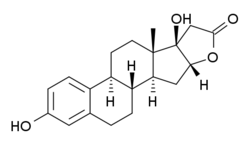16α-LE2
16α-LE2, or 16α-lactone-estradiol, also known as 3,17β-dihydroxy-19-nor-17α-pregna-1,3,5-(10)-triene-21,16α-lactone, is a synthetic, steroidal estrogen featuring an estradiol core. It is a highly potent and selective agonist of the ERα that is used in scientific research to study the function of the ERα.[1][2] It has 265-fold higher potency in transactivation assays of the ERα relative to the ERβ and 70-fold preference in binding affinity for the ERα over the ERβ.[2]
 | |
| Identifiers | |
|---|---|
IUPAC name
| |
| CAS Number | |
| ChemSpider | |
| Chemical and physical data | |
| Formula | C20H24O4 |
| Molar mass | 328.402 g/mol g·mol−1 |
| 3D model (JSmol) | |
SMILES
| |
InChI
| |
In rodents, 16α-LE2 has no effect on ovarian follicle development, whereas the highly ERβ-selective agonist 8β-VE2 stimulates follicular growth and to a comparable extent as estradiol, indicating that the ERβ and not the ERα is involved in the effects of estrogen on ovarian follicles.[2][3] In contrast, 16α-LE2 stimulates uterine weight, whereas 8β-VE2 has no effect, indicating that the ERα and not the ERβ is involved in the effects of estrogen on the uterus.[2] Research has determined through experimental rodent studies with estradiol, 16α-LE2, and 8β-VE2 that the positive, protective effects of estrogens on bone formation resorption and bone mineral density are mediated via the ERα, whereas the ERβ does not appear to be involved.[4]
See also
References
- I Shaw (31 March 2009). Endocrine-Disrupting Chemicals in Food. Elsevier. pp. 550–. ISBN 978-1-84569-574-3.
- Hegele-Hartung C, Siebel P, Peters O, Kosemund D, Müller G, Hillisch A, Walter A, Kraetzschmar J, Fritzemeier KH (2004). "Impact of isotype-selective estrogen receptor agonists on ovarian function". Proc. Natl. Acad. Sci. U.S.A. 101 (14): 5129–34. doi:10.1073/pnas.0306720101. PMC 387385. PMID 15037755.
- Tony M. Plant; Anthony J. Zeleznik (15 November 2014). Knobil and Neill's Physiology of Reproduction. Academic Press. pp. 1150–. ISBN 978-0-12-397769-4.
- Hertrampf T, Schleipen B, Velders M, Laudenbach U, Fritzemeier KH, Diel P (2008). "Estrogen receptor subtype-specific effects on markers of bone homeostasis". Mol. Cell. Endocrinol. 291 (1–2): 104–8. doi:10.1016/j.mce.2008.03.003. PMID 18433985.